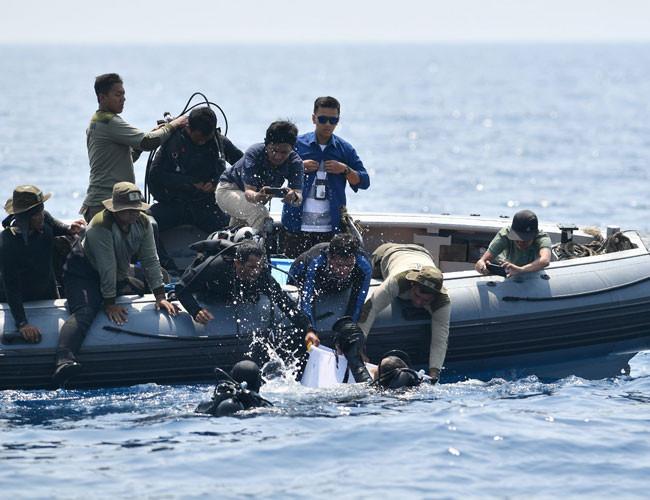Divers recover jet's data recorder on Indonesia seafloor
JAKARTA – The Associated Press

Divers on Nov. 1 recovered a flight data recorder from the crashed Lion Air jet on the seafloor, a crucial development in the investigation into what caused the 2-month-old plane to plunge into Indonesian seas earlier this week, killing all 189 people on board.
One TV station showed footage of two divers after they surfaced, swimming to an inflatable vessel and placing the bright orange device into a large container that was transferred to a search-and-rescue ship.
"I was desperate because the current below was strong but I am confident of the tools given to me," said navy 1st Sgt. Hendra, who uses a single name, in a television interview. After narrowing the possible location, "I started digging and cleaning the debris until I finally found an orange object," he said, standing on the deck of a ship next to his diving mate.
The Boeing 737 MAX 8 plane crashed early Oct. 29 just minutes after takeoff from the Indonesian capital Jakarta. It was the worst airline disaster in Indonesia in more than two decades and renewed concerns about safety in its fast-growing aviation industry, which was recently removed from European Union and U.S. blacklists.
Navy Col. Monang Sitompul told local TV an object believed to be the aircraft's fuselage was also seen on the seafloor.
The device recovered by divers is the flight data recorder and the search for the cockpit voice recorder continues, said Bambang Irawan, an investigator with the National Transport Safety Commission.
"We will process the data contained in this FDR as part of the investigation process to find out the cause of the crash," he said. "We cannot say how long it takes to process data in a black box, but of course we will try as soon as possible."
The location of the find was about 500 meters (yards) northwest of the coordinates where the plane lost contact and at a depth of 30 meters, said search and rescue agency head Muhammad Syaugi.
"The currents below the sea are still strong which make it difficult for divers, but they persistently face it," he said.
Data from flight-tracking sites show the plane had erratic speed and altitude in the early minutes of a flight on Oct. 28 and on its fatal flight on Oct. 29. Safety experts caution, however, that the data must be checked for accuracy against the flight data recorder.
Several passengers on the Oct. 28 flight from Bali to Jakarta have recounted problems that included a long-delayed takeoff for an engine check and terrifying descents in the first 10 minutes in the air.
Lion Air has ordered 50 of the MAX 8 planes and one of its subsidiary airlines was last year the first to operate the new generation jet.
Investigators say a preliminary report into the accident could be released within a month but complete findings will take several months more.
The Lion Air crash is the worst airline disaster in Indonesia since 1997, when 234 people died on a Garuda flight near Medan. In December 2014, an AirAsia flight from Surabaya to Singapore plunged into the sea, killing all 162 on board.
Indonesian airlines were barred in 2007 from flying to Europe because of safety concerns, though several were allowed to resume services in the following decade. The ban was completely lifted in June. The U.S. lifted a decadelong ban in 2016.
Lion Air, a discount carrier, is one of Indonesia's youngest and biggest airlines, flying to dozens of domestic and international destinations. It has been expanding aggressively in Southeast Asia, a fast-growing region of more than 600 million people.
















